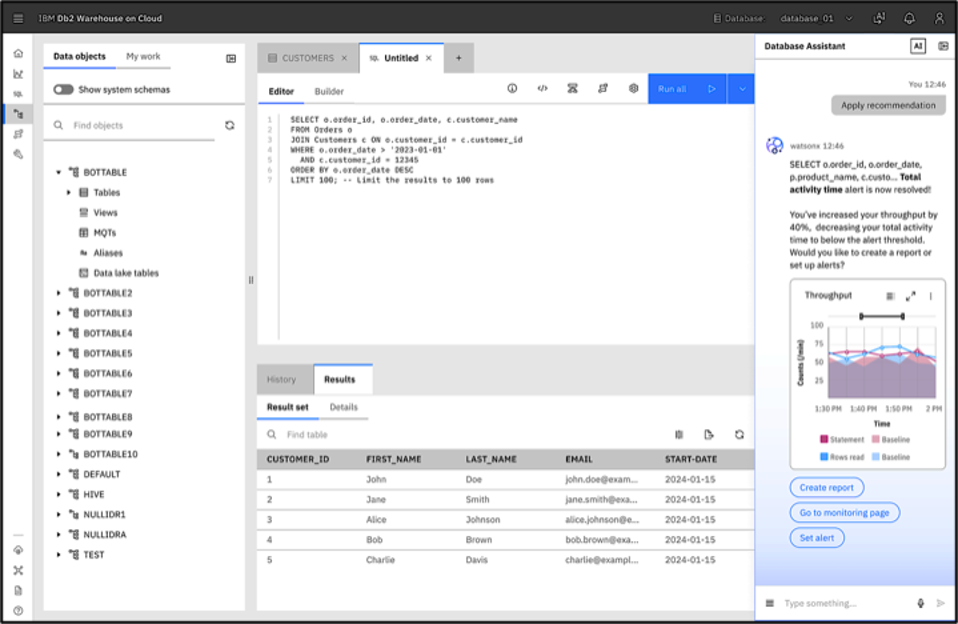
The world of enterprise data is evolving at an incredible pace, and businesses are grappling with increasingly complex data landscapes. This demands more from their database systems than ever before. IBM aims to meet these needs with version 12.1 of its venerable Db2 database, set for GA release this week. The new release builds on Db2’s long history while embracing AI functionality to redefine database management.
Db2 12.1 addresses the challenges faced by database administrators who manage large (and rapidly growing) data volumes while needing to maintain performance, security and uptime. As a key facet of its approach, IBM has introduced a generative AI-driven Database Assistant powered by IBM watsonx to provide instant answers, real-time monitoring and intelligent troubleshooting. In this article, I will take a closer look at IBM Db2 and the new standard it aims to set for enterprise databases.

Introducing The AI-Powered Database Assistant
The new Database Assistant is designed to reduce downtime by resolving issues in real time and preventing disruptions. DBAs can interact with the system using natural language to get quick answers, even for complex questions, without needing to consult manuals.
In my recent discussion with Miran Badzak, program director for databases at IBM, he stated, “Our Db2 DBAs are constantly challenged to manage an always-growing estate of mission-critical databases, where any sort of disruption represents millions of dollars in potential losses.” According to Badzak, the new Database Assistant “makes it easy for novice and seasoned DBAs alike to efficiently manage large Db2 database deployments, resolve database problems faster than [with] traditional tooling and significantly improve their overall operational efficiency.”
Besides its troubleshooting capabilities, the Database Assistant also acts as a virtual mentor, accelerating DBA onboarding by providing answers tailored to the specific Db2 instance. This reduces both training time and costs. The Database Assistant should enable DBAs to resolve issues quickly and proactively, allowing them to focus on strategic projects that enhance the organization’s efficiency and competitiveness.
IBM Db2 Enhanced Performance And Capabilities
Besides the Database Assistant, the Db2 12.1 release has more than 200 new features, especially to enhance AI integration for managing both structured and unstructured data. In discussing the new release, Badzak highlighted the AI connection: “Our [IBM’s] mission is to make it easy for enterprises to build the next generation of AI apps and services by combining their highly curated, mission-critical structured data stored in Db2 databases with their treasure trove of unstructured data—documents, PDFs, images, web pages—that have formed the core of their business. We believe that the combination of these datasets will form the basis for a new generation of AI-powered apps and serve as clear and undisputed differentiators for our customers in their respective markets.”
A major highlight of the new release is AI-driven query optimization, which enables automated tuning and improves predictive analytics and intelligent resource allocation. This AI optimization results in faster, more efficient query processing, whether the system is handling structured data from transactional systems or unstructured data from documents and multimedia sources like Badzak mentioned.
Db2 12.1 also introduces a new tenancy model with namespace separation, allowing for better resource management by isolating multiple datasets within a single database. This is a crucial feature for organizations managing diverse data types under a unified system. Also, for high availability and disaster recovery, the Db2 pureScale feature on Linux now uses Pacemaker cluster resource management instead of IBM Tivoli System Automation, which should lead to faster failure recovery times and more reliable operations.
The release brings enhancements in scalability as well, especially for cloud environments, with improved object storage handling for both structured and unstructured data types. Performance upgrades include intra-tablespace parallelism for faster backups and optimized columnar table operations, with schema evolution options including Drop/Rename support and enhanced Update/Join performance.
For developers, Apple Silicon driver support is now available for Db2, adding flexibility in database interactions. Security is strengthened through features including trusted context for stored procedures, audit exceptions for trusted applications and SSL support, which enables securing data-in-transit even in high availability disaster recovery setups.
To round out the offering, a new Db2 Starter Edition provides a focused set of data-management capabilities tailored for new applications and services. This broadens options for businesses using Db2 based on their specific data-management needs.
IBM’s Roadmap For Db2
IBM’s 2025 roadmap for Db2 further emphasizes AI integration and enhanced management capabilities. Planned updates include an in-database vector store, similarity search and watsonx.ai integration, which will enable SQL-based interaction with large language models. Further enhancements to the Database Assistant, such as a smart SQL workbench and an AI-driven monitoring hub, are designed to streamline complex tasks and strengthen system reliability. These updates align with broader trends in automation and AI to enable more efficient data handling.
An Important Step Forward For Db2—And Database Management
In my view, with its support for varied data sources and improved performance features, Db2 12.1 provides a strong approach to managing both structured and unstructured data. This functionality supports enterprise efforts to update data-management practices, enabling a more effective use of data assets.
In the bigger picture, I believe the launch of IBM Db2 12.1 with the AI-powered Database Assistant marks a meaningful step toward a more autonomous and adaptive future for database management. By integrating Db2 with watsonx (the development of which I’ve been covering for more than a year), IBM is not only tackling traditional database challenges but also positioning Db2 as a forward-thinking solution aligned with the needs of modern data environments. I think this is especially remarkable when we recall that Db2 has been a stalwart of IBM’s enterprise technology lineup since the 1980s.
Db2 12.1’s support for both structured and unstructured data, along with AI-driven functions such as predictive analytics and intelligent troubleshooting, makes it a strong choice for enterprises looking to simplify data management. Features such as in-database vector storage and similarity search should further unify operational data and support the creation of smarter applications. IBM’s roadmap demonstrates a strong commitment to this approach, making Db2 a compelling option for the growing demands of data-intensive environments.























































































